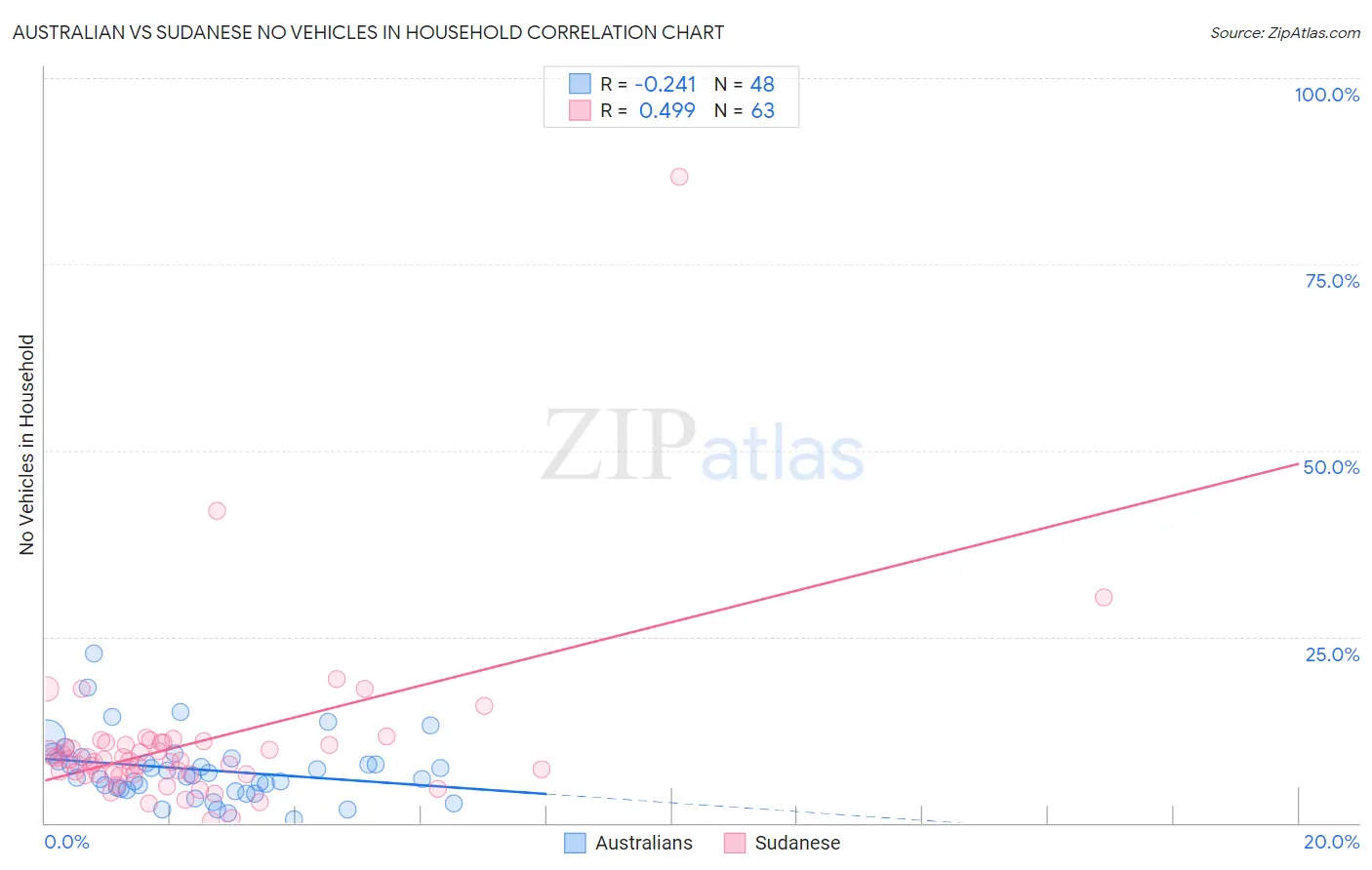Australian vs Sudanese No Vehicles in Household
COMPARE
Australian
Sudanese
No Vehicles in Household
No Vehicles in Household Comparison
Australians
Sudanese
10.1%
NO VEHICLES IN HOUSEHOLD
70.6/ 100
METRIC RATING
157th/ 347
METRIC RANK
9.8%
NO VEHICLES IN HOUSEHOLD
83.1/ 100
METRIC RATING
141st/ 347
METRIC RANK
Australian vs Sudanese No Vehicles in Household Correlation Chart
The statistical analysis conducted on geographies consisting of 223,715,583 people shows a weak negative correlation between the proportion of Australians and percentage of households with no vehicle available in the United States with a correlation coefficient (R) of -0.241 and weighted average of 10.1%. Similarly, the statistical analysis conducted on geographies consisting of 110,072,180 people shows a moderate positive correlation between the proportion of Sudanese and percentage of households with no vehicle available in the United States with a correlation coefficient (R) of 0.499 and weighted average of 9.8%, a difference of 2.6%.

No Vehicles in Household Correlation Summary
| Measurement | Australian | Sudanese |
| Minimum | 0.57% | 0.33% |
| Maximum | 22.8% | 86.7% |
| Range | 22.2% | 86.3% |
| Mean | 7.1% | 10.6% |
| Median | 6.3% | 8.4% |
| Interquartile 25% (IQ1) | 4.5% | 6.6% |
| Interquartile 75% (IQ3) | 8.5% | 10.8% |
| Interquartile Range (IQR) | 4.0% | 4.2% |
| Standard Deviation (Sample) | 4.4% | 11.6% |
| Standard Deviation (Population) | 4.3% | 11.5% |
Demographics Similar to Australians and Sudanese by No Vehicles in Household
In terms of no vehicles in household, the demographic groups most similar to Australians are Immigrants from Micronesia (10.1%, a difference of 0.050%), Spanish American Indian (10.1%, a difference of 0.060%), Immigrants from Indonesia (10.1%, a difference of 0.21%), Salvadoran (10.1%, a difference of 0.30%), and Sioux (10.1%, a difference of 0.31%). Similarly, the demographic groups most similar to Sudanese are Immigrants from Zimbabwe (9.9%, a difference of 0.13%), Immigrants from Lithuania (9.8%, a difference of 0.22%), Marshallese (9.8%, a difference of 0.23%), Chilean (9.9%, a difference of 0.48%), and Immigrants from Bahamas (9.9%, a difference of 0.48%).
| Demographics | Rating | Rank | No Vehicles in Household |
| Marshallese | 84.0 /100 | #139 | Excellent 9.8% |
| Immigrants | Lithuania | 84.0 /100 | #140 | Excellent 9.8% |
| Sudanese | 83.1 /100 | #141 | Excellent 9.8% |
| Immigrants | Zimbabwe | 82.6 /100 | #142 | Excellent 9.9% |
| Chileans | 81.2 /100 | #143 | Excellent 9.9% |
| Immigrants | Bahamas | 81.2 /100 | #144 | Excellent 9.9% |
| Bahamians | 81.0 /100 | #145 | Excellent 9.9% |
| Hungarians | 80.0 /100 | #146 | Excellent 9.9% |
| Immigrants | Nicaragua | 79.8 /100 | #147 | Good 9.9% |
| Immigrants | Bosnia and Herzegovina | 79.1 /100 | #148 | Good 9.9% |
| Immigrants | Uganda | 76.1 /100 | #149 | Good 10.0% |
| Colombians | 73.9 /100 | #150 | Good 10.0% |
| Immigrants | Eastern Africa | 73.8 /100 | #151 | Good 10.0% |
| Immigrants | Congo | 73.0 /100 | #152 | Good 10.1% |
| Tlingit-Haida | 72.5 /100 | #153 | Good 10.1% |
| Sioux | 72.4 /100 | #154 | Good 10.1% |
| Salvadorans | 72.4 /100 | #155 | Good 10.1% |
| Immigrants | Micronesia | 70.9 /100 | #156 | Good 10.1% |
| Australians | 70.6 /100 | #157 | Good 10.1% |
| Spanish American Indians | 70.2 /100 | #158 | Good 10.1% |
| Immigrants | Indonesia | 69.3 /100 | #159 | Good 10.1% |